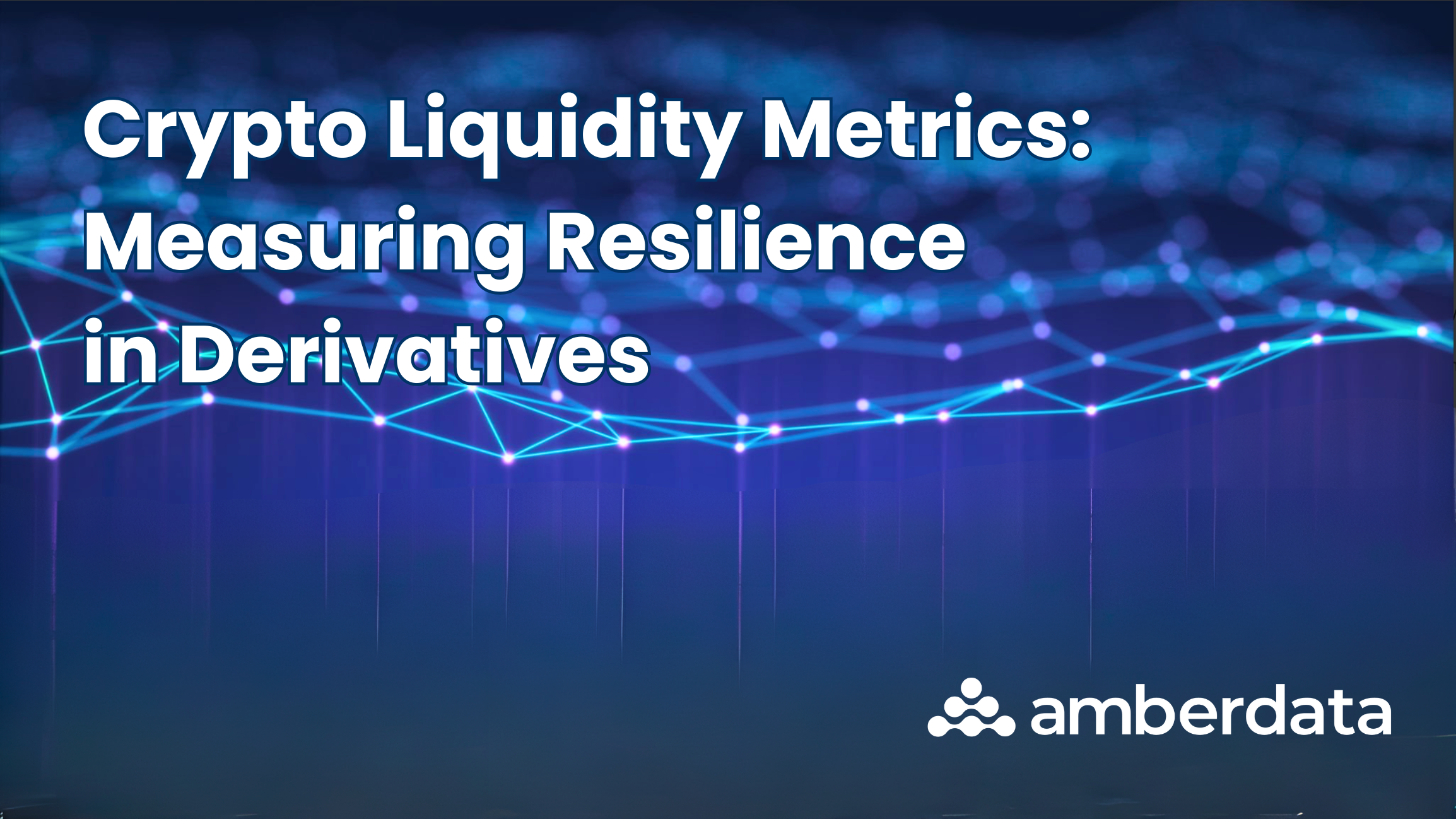Crypto Liquidity Metrics: Measuring Resilience in Derivatives

Liquidity in crypto derivatives markets, particularly for assets like Bitcoin (BTC) and Ethereum (ETH), is crucial during periods of high volatility, as it ensures efficient trade execution and market stability. Without it, traders would simply not be able to trade these assets. Assessing liquidity in the crypto space presents unique challenges due to market fragmentation and varying exchange standards. Amberdata AD Derivatives offers institutional-grade analytics, including 24-hour volume and open interest metrics, essential for understanding liquidity trends during volatile events. Additionally, the DVOL Index is a crucial indicator of volatility levels for BTC and ETH, providing traders with valuable insights into market dynamics.
Defining Liquidity in Crypto Derivatives
Liquidity in crypto derivatives refers to the ease with which positions can be entered or exited without significantly impacting the asset's price. Essential proxies for assessing liquidity include trading volume and open interest.
Trading Volume
Trading volume reflects the total number of contracts traded within a specific period, indicating the level of market activity. Amberdata's 24-hour volume metrics, categorized by exchange, currency, and expiration, offer insights into where and when trading is most active, helping traders identify liquidity concentrations across different platforms and contract maturities.
Open Interest
Open interest represents the total number of outstanding derivative contracts that have not been settled. Monitoring open Interest by exchange, currency, and expiration provides a snapshot of market participation and sentiment, revealing the commitment levels of market participants and potential future price movements.
Importance of Liquidity Dynamics During High Volatility
Understanding liquidity dynamics becomes even more critical during high-volatility events, where Amberdata's volatility charts come in. Amberdata's DVOL Index, akin to a crypto-specific VIX, measures implied volatility in assets like Bitcoin and Ethereum. By analyzing the DVOL Index alongside volume and open interest data, traders can gauge market sentiment and anticipate liquidity shifts, enabling more informed decision-making in turbulent market conditions.
Metrics for Institutional Investors
Institutional investors utilize 24-hour trading volume and open interest metrics to assess market stability and adjust their risk tolerance accordingly. High 24-hour trading volumes indicate robust market activity, suggesting that large transactions can be executed with minimal price impact, thereby reducing slippage and enhancing market stability. Conversely, low trading volumes may signal potential liquidity issues, increasing volatility, price dislocations, and overall crypto market sentiment.
Role of Open Interest
Open interest, representing the total number of outstanding derivative contracts, is a market participation and sentiment gauge. An increased open interest indicates that new positions are being established, reflecting growing confidence among market participants. Conversely, a decline suggests position liquidations, which may point to waning confidence or profit-taking.
High-Volatility Events and Market Trends
During periods of heightened volatility in the cryptocurrency market, institutional investors often observe increases in open interest for Bitcoin (BTC) and Ethereum (ETH) futures contracts. This trend indicates growing market participation and potential future price movements. For instance, in 2022, ETH options markets surpassed BTC in volume and open interest for the first time, with institutional block trading activity in ETH options increasing by over 300%.
Amberdata's platform provides comprehensive BTC and ETH-specific metrics, including detailed analytics on 24-hour volume and open interest across various exchanges and contract expirations. These tools enable institutional investors to monitor real-time liquidity conditions, facilitating informed decisions aligning with risk management strategies.
By integrating these metrics into their analysis, institutional investors can effectively gauge market stability, adjust their risk tolerance, and capitalize on opportunities within the crypto derivatives market.
Utilizing Volatility Data for Strategic Advantage
High-volatility events, as indicated by the Deribit Volatility Index (DVOL), present both challenges and opportunities for traders. A surge in the DVOL suggests increased market uncertainty, leading to wider bid-ask spreads and potential price dislocations. However, traders equipped with real-time liquidity data can capitalize on these fluctuations. For example, when the DVOL spiked to a 16-month high, informed traders leveraged this data to implement volatility arbitrage strategies, profiting from the rapid price movements.
Amberdata Derivatives offers comprehensive metrics that enhance strategy refinement in BTC and ETH markets. Traders gain insights into liquidity patterns and market sentiment by providing detailed analytics on 24-hour volume and open interest across various exchanges and contract expirations. For instance, observing a consistent increase in open interest for ETH options may indicate bullish sentiment, guiding traders to adjust their portfolios accordingly. Additionally, Amberdata's tools facilitate the analysis of DeFi liquidity, enabling traders to assess decentralized exchange volumes and liquidity pool dynamics, further informing their trading decisions.
Incorporating these metrics into trading strategies allows institutional investors to navigate high-volatility events effectively, aligning their actions with prevailing liquidity patterns to optimize outcomes in the crypto derivatives market.
Conclusion
Liquidity is fundamental to maintaining market stability, especially during high-volatility events. It ensures that assets can be traded efficiently without causing significant price fluctuations, thereby preserving market integrity. Amberdata Derivatives offers comprehensive metrics—including 24-hour volume, open interest, and the DVOL Index—essential tools for traders and institutional investors. These metrics provide actionable insights into market dynamics, enabling informed decision-making and effective risk management. For a deeper analysis and to enhance your trading strategies in Bitcoin (BTC) and Ethereum (ETH) derivatives markets, we encourage you to explore Amberdata's offerings.
Amberdata
Amberdata is the leading provider of global financial infrastructure for digital assets. Our institutional-grade solutions deliver data, analytics and comprehensive tools and insights that empower financial institutions to research, trade, and manage risk and compliance in digital assets. Amberdata serves as a...
